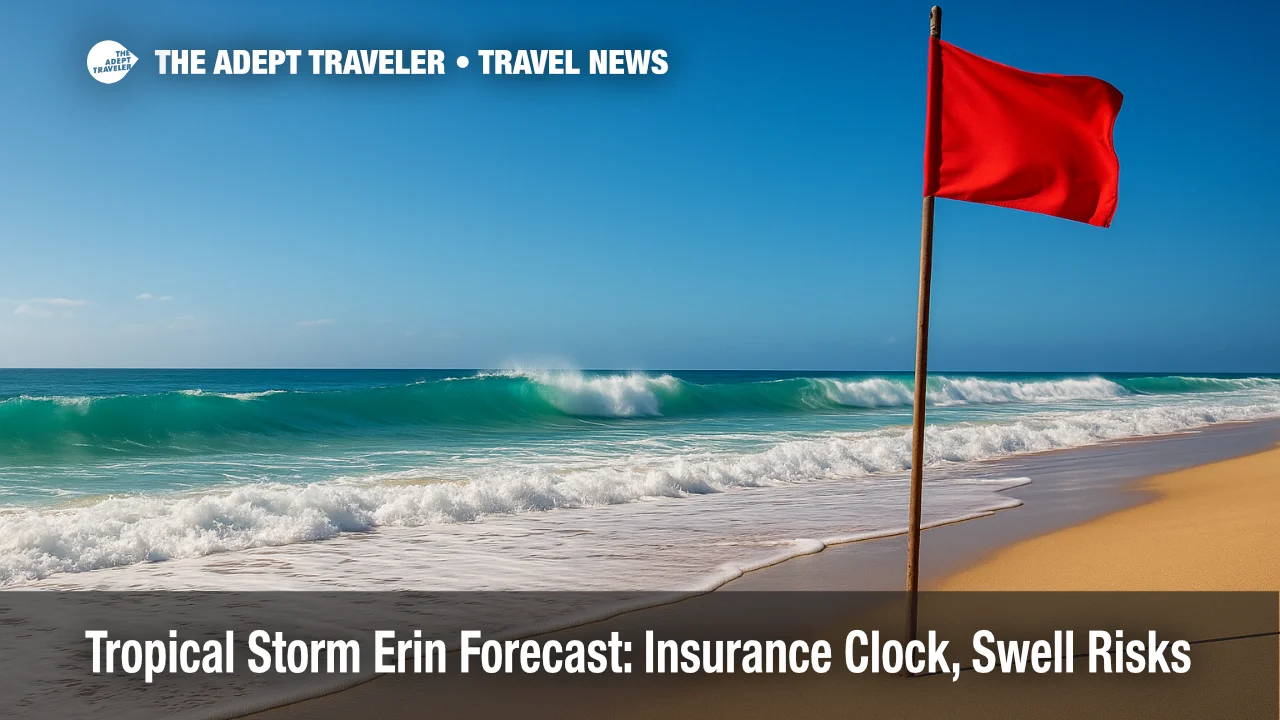Tropical Storm Erin Forecast: Insurance Clock, Swell Risks

Tropical Storm Erin formed in the eastern Atlantic on August 11 and is expected to intensify as it moves west to west-northwest. Forecast guidance keeps strengthening likely and a turn toward the northwest later this week. It is too soon to know direct island impacts. However, the "named-storm" insurance clock has started, and long-period swell and rip currents can precede any cone shift. Here is the actionable view. 1, 2
Executive Summary
Erin is a strengthening tropical storm far east of the Lesser Antilles, with hurricane strength possible later this week. The earliest reasonable window for tropical-storm-force winds near the northern Leewards does not open until late Friday into Saturday, if at all. Swell and rip current hazards can arrive days before any track adjustment. 1, 3, 4
Key Metrics Snapshot
- Why it matters: Once Erin was named on August 11, many travel and property insurance provisions changed status. 7, 8
- Travel impact: Northern Leewards should monitor daily, with earliest reasonable TS-wind arrival no sooner than late Fri-Sat, Aug 15-16. 1, 3, 4
- What's next: Erin could become the Atlantic season's first hurricane later this week if conditions remain favorable. 1, 5
- Forward motion: generally west to west-northwest, then gradual turn to the northwest this weekend. 1
- Watches and warnings: none in effect as of Monday evening. 2
Background
At 5 p.m. AST Monday, Erin's maximum sustained winds were near 45 mph, with gradual strengthening forecast over the next several days. The National Hurricane Center projects Erin to gain latitude near 55-60°W late week as environmental conditions improve. Key Messages stress that it is still too early to determine impacts to the northern Leeward Islands or the U.S. East Coast. 1, 2
Data And Analysis
The Named-Storm Insurance Clock, Explained
Once a system is assigned a name, many insurance rules switch from "unforeseen" to "foreseen." For travel insurance, policies generally exclude new claims tied to that specific storm if the plan is purchased after naming. Buy early for future storms, or consider optional "Cancel For Any Reason" where available. Regulators summarize this foreseeability principle in consumer guidance. 8
For home and property policies in hurricane-prone states, special named-storm or hurricane deductibles may apply when losses are caused by a named cyclone, with triggers and percentages varying by state and insurer. In addition, carriers often impose short-term binding suspensions that pause new policies or coverage increases when a storm threatens a region. Recent state-backed examples document these temporary moratoriums. Travelers closing on property, charterers, or yacht operators along common staging ports should plan ahead. 7, 9
When Should the Lesser Antilles Start Monitoring?
Based on NHC track and timing products, the earliest reasonable chance for tropical-storm-force winds near the northern Leeward Islands does not begin until late Friday into Saturday (August 15-16), and only if the wind field expands and the track stays far enough west. That "earliest reasonable" window corresponds to a 10 percent arrival probability, the benchmark NHC recommends for low-risk-tolerance planning. Begin daily checks now, escalate to 12-hourly review from Wednesday. Airports most sensitive to schedule shifts include V. C. Bird International Airport - (ANU), St. John's, Antigua and Barbuda, Princess Juliana International Airport - (SXM), Simpson Bay, Sint Maarten, and Grantley Adams International Airport - (BGI), Bridgetown, Barbados. Always defer to local officials if watches or warnings are issued. 1, 3, 4
Why Swell And Rip Currents Can Arrive Early
You can see dangerous surf without any cone change. Erin's winds can generate long-period swell that travels hundreds or even thousands of miles, reaching shorelines days in advance of any direct impact. Those swells enhance rip current risk even under sunny skies. NOAA documents deadly U.S. rip current episodes from storms that stayed far offshore, underscoring the need for surf-zone awareness well before a system nears land. Check local NWS Surf Zone Forecasts and obey beach-flag warnings. 10, 11
Implications For Travelers
- If you already bought a comprehensive travel policy before August 11, review covered reasons for weather-related cancellation, interruption, or delay, and keep receipts. 8
- If you have not purchased insurance yet, new policies typically will not cover losses caused by Erin specifically, though they can cover unrelated future storms. Consider broader options if available. 8
- For Caribbean trips this weekend into next week, build flexible buffers, track airline waivers, and watch NHC arrival-time and wind-probability updates at least twice daily. Cruise passengers should monitor line advisories. 3, 4
- Beach plans from the Lesser Antilles to the Bahamas should factor in early swell and rip current hazards. Choose guarded beaches and heed lifeguards. 10, 11
Final Thoughts
Bottom line, the tropical storm erin forecast favors strengthening over open water this week, with monitoring priority on timing, swell, and the insurance clock that started at naming. Stay forecast-focused, not model-run-to-model-run, and use official updates to guide decisions. 1, 2, 3
Sources
- Tropical Storm Erin Forecast Discussion - National Hurricane Center (NHC)
- Tropical Storm Erin Public Advisory - NHC
- Arrival of Tropical-Storm-Force Winds, Product Description - NHC
- Erin: Arrival-Time and Cone Graphics Hub - NHC
- Erin could become the Atlantic's first hurricane later this week - AP
- What Are Named-Storm Deductibles? - NAIC
- Should You Get Travel Insurance? Hurricane foreseeability - NAIC
- Citizens Property Insurance: Binding Suspension example
- NWS Rip Current Safety: Distant hurricanes and swell
- NOAA NHC Blog "Inside the Eye": Rip Currents, the Hidden Hurricane Hazard
